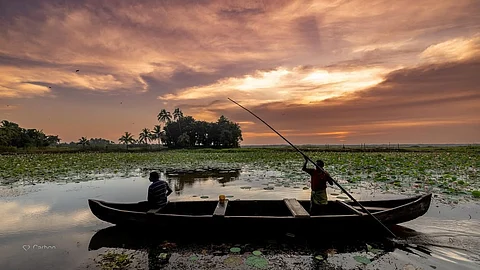
- Destinations
- Experiences
- Stay
- What's new
- Celebrating People
- Responsible Tourism
- CampaignsCampaigns
- SubscribeSubscribe
- Buy Now

In the centre of Kerala’s Thrissur district lies one of the most profound secrets in the shape of a tranquil village named Pullu. A peaceful paradise tucked away from the traditional tourist routes, Pullu is sought-after for its vast and green paddy fields, abundant avian life and genuine local experiences. With a regular influx of influencers full of beans and formidable tourism ventures on the cards, Pullu is poised to entertain tourists.
Pullu, which is separated into Vadakkan Pullu (Northern Pullu) and Thekkan Pullu (Southern Pullu), is located around 12.5 km from Thrissur town. A nourishing low-lying region known for its substantial rice production, the community is a component of the greater Kole Wetlands. In addition to making a substantial contribution to Kerala's rice production, these wetlands act as organic drainage systems for the nearby areas.
The traditional Kole farming system defines Pullu's agricultural landscape. This technique involves keeping fields immersed in water for roughly five months in a year, with cultivation taking place during the dry spells. Here, Jyoti and Uma are the most common types of rice.
These areas are used for fish farming during the rainy months, where species like catla, prawn, and rohu are cultivated. The cycle of growing fish and rice alternately improves soil fertility and lessens the demand for chemical fertilisers.
The paddy fields, known locally as Pullu Padam, are a birdwatcher's delight. A little more than a bunch of migratory species visit the Kole Wetlands, which are a part of the Central Asian Flyway. The spot-billed pelican, oriental darter, black-headed ibis and painted stork are among the notable individuals that a birder’s eye stands to observe in the region. BirdLife International has designated the area as one of India's Important Bird Areas due to its great avian diversity.
Pullu's natural and aesthetic appeal changes with the seasons. Large stretches of verdant paddy fields dominate the scene in the summer, making for a calming visual feast. These fields turn into reflected water bodies during monsoon rains, evoking the renowned backwaters of Kerala. The area's beauty is further enhanced by this seasonal flooding, which makes it a photographer's paradise.
Among the many hours of the day, Pullu's evenings are particularly captivating. When the fields are bathed in a golden glow as the sun sets, it makes for views one can sit and absorb. In order to capture the tranquil moments as the sun sets, visitors frequently congregate to watch this everyday show. Recreational opportunities in the vicinity include coracle boat excursions around the canals, which offer a distinctive viewpoint of the village's waterways.
A must-visit for anyone looking for a genuine culinary experience is Pullu Shaapu, the local toddy shop. Pullu Shaapu is a concrete building tucked away in the Kole environs, in contrast to customary thatched eateries. It is well known for a number of delicious foods and fresh toddy, a moderately alcoholic beverage created from palm sap. Freshwater fish, oysters, and crabs that are sourced straight from the nearby fields are among the specialities. Combining these dishes with spicy curries and boiling tapioca creates a gourmet experience that is firmly anchored in Keralan cuisine.
There are roughly 1,196 people living in Pullu, divided across 292 households, according to the 2011 Census. Kerala's excellent educational levels are reflected in the village's high literacy rate of 95.77 per cent. The Scheduled Caste community makes up a sizeable section of the populace, adding to the village's rich cultural diversity.
The best time of year to visit Pullu is between September and April, when the weather is mild and the fields are either gorgeously flooded or rich green. Because they provide the best lighting and more bird activity, early mornings and late afternoons are especially fruitful times for photographers and bird watchers.
Pullu can be reached easily. Travellers can continue towards Pullu by turning left at Manakody Auto Stand on the Thrissur-Kanjany-Vadanappally road from Thrissur. The settlement can also be reached by turning right at Palakkal for those travelling along the Kodungallur-Shornur road. The location is reachable by road, and there are guest parking spaces available.
